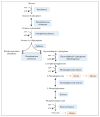Evidence for brain glucose dysregulation in Alzheimer's disease
- PMID: 29055815
- PMCID: PMC5866736
- DOI: 10.1016/j.jalz.2017.09.011
Evidence for brain glucose dysregulation in Alzheimer's disease
Abstract
Introduction: It is unclear whether abnormalities in brain glucose homeostasis are associated with Alzheimer's disease (AD) pathogenesis.
Methods: Within the autopsy cohort of the Baltimore Longitudinal Study of Aging, we measured brain glucose concentration and assessed the ratios of the glycolytic amino acids, serine, glycine, and alanine to glucose. We also quantified protein levels of the neuronal (GLUT3) and astrocytic (GLUT1) glucose transporters. Finally, we assessed the relationships between plasma glucose measured before death and brain tissue glucose.
Results: Higher brain tissue glucose concentration, reduced glycolytic flux, and lower GLUT3 are related to severity of AD pathology and the expression of AD symptoms. Longitudinal increases in fasting plasma glucose levels are associated with higher brain tissue glucose concentrations.
Discussion: Impaired glucose metabolism due to reduced glycolytic flux may be intrinsic to AD pathogenesis. Abnormalities in brain glucose homeostasis may begin several years before the onset of clinical symptoms.
Keywords: Alzheimer's disease; GLUT1; GLUT3; Glucose; Glycolysis; Insulin resistance; Mass spectrometry; Neuritic plaque; Neurofibrillary tangles.
Copyright © 2017 the Alzheimer's Association. All rights reserved.
Conflict of interest statement
Figures





References
-
- Leibson CL, Rocca WA, Hanson VA, Cha R, Kokmen E, O'Brien PC, et al. Risk of dementia among persons with diabetes mellitus: a population-based cohort study. American journal of epidemiology. 1997;145:301–8. - PubMed
-
- Luchsinger JA, Tang MX, Stern Y, Shea S, Mayeux R. Diabetes mellitus and risk of Alzheimer's disease and dementia with stroke in a multiethnic cohort. American journal of epidemiology. 2001;154:635–41. - PubMed
-
- Ott A, Stolk RP, van Harskamp F, Pols HA, Hofman A, Breteler MM. Diabetes mellitus and the risk of dementia: The Rotterdam Study. Neurology. 1999;53:1937–42. - PubMed
-
- Chen Z, Zhong C. Decoding Alzheimer's disease from perturbed cerebral glucose metabolism: implications for diagnostic and therapeutic strategies. Progress in neurobiology. 2013;108:21–43. - PubMed
-
- Hoyer S. Brain glucose and energy metabolism abnormalities in sporadic Alzheimer disease. Causes and consequences: an update. Experimental gerontology. 2000;35:1363–72. - PubMed
Publication types
MeSH terms
Substances
Grants and funding
LinkOut - more resources
Full Text Sources
Other Literature Sources
Medical
Miscellaneous

